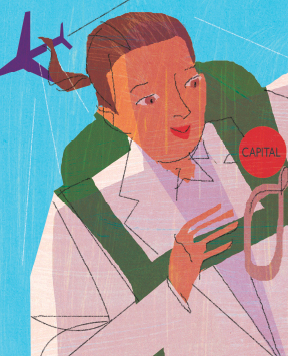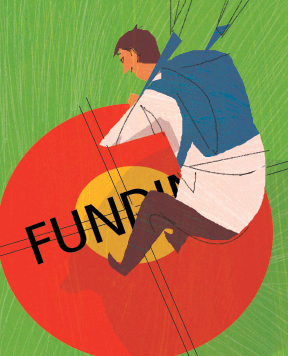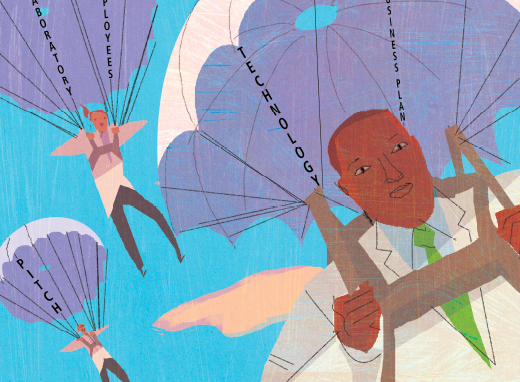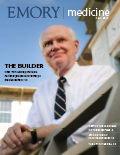The Art of the Sell
By Quinn Eastman / Illustrations by Richard Allen
A scientist comfortable with running a laboratory may still find the worlds of corporate finance and venture capital daunting.
Are you smart enough to know that you don't know everything?
If you want to take a product to market that you have spent years developing, you better check your ego at the door, says one venture capitalist who recently helped coach Emory medical school faculty.
 |
"Venture capitalists want to know whether you are coachable," says Donovan Moxey. "You should be smart enough to know that you don't know everything."
Moxey, who founded LIPSinc, a 3D animation software company in North Carolina, knew that he didn't know much back in 1998 when he was developing his software. He turned to FastTrac Tech, a course offered by the Council for Entrepreneurial Development (CED) to stimulate high-tech companies in the Greater Research Triangle area. Moxey completed the course in August of that year, and by October he had raised $500,000. By February 1999, he had closed in on $1.3 million in first-round funding.
Today he sits on the board of CED and shares his experiences with other budding entrepreneurs, like the 22 from Emory, Georgia Tech, and the University of Georgia who were taking the course this past spring on the Emory campus. The six-week FastTrac was sponsored by Emory's Office of Technology Transfer, which helps shepherd faculty inventions from the lab bench to the hands of a commercial partner. In addition to Moxey, the group also heard from four other CEOs, three COOs, an executive recruiter, a patent attorney, and a venture capitalist.
"Several Emory faculty members have had success starting their own companies, and one of the goals of the program is to help make that group larger," says Todd Sherer, director of the Office of Technology Transfer. "Another is to let aspiring entrepreneurs know more about how start-ups work. We want them to be prepared for the process of working with business leaders and investors."
Many doctors and scientists have great ideas, Sherer says, but they still need investors, patent protection, and eventually the ability to pay employees. A scientist who is comfortable running a laboratory or preparing a grant application may still find the worlds of corporate finance and venture capital daunting.
And finding funding in today's depressed economy can be especially trying.
Challenging times
Currently, inventors face a shrunken venture capital sector and a relative lack of high-tech business know-how in the Atlanta metro area. In addition, to pass muster with the FDA, companies that are developing new drugs will have to withstand the testing of clinical trials, which are becoming more expensive.
Stephen Snowdy, principal of Ansley Ventures, explained to course attendees that venture capital firms like his were pulling back, especially in the biotechnology and medical device areas. Firms typically are interested only in investing in a start-up that has already grown to a substantial size. Ironically, this means that entrepreneurs need to start earlier than ever in their search for potential investors.
"You cannot wait for us to come to you," Snowdy said. "The earlier you can make connections, the easier it's going to be to make your pitch."
And keep it short and simple, Moxey emphasized. If an entrepreneur can't make an "elevator pitch" in a few minutes, he or she won't be convincing, Moxey says.
Both Snowdy and Moxey urged participants to look outside Atlanta for business contacts. There are fewer than five venture capital firms in Atlanta that support the life sciences, says Kevin Lei, director of faculty and start-up services for Emory's Office of Technology Transfer. In fact, a 2009 Georgia Tech study found that 40% of Atlanta's high-tech start-up companies leave for other states within three years. Lei says the short supply of start-up CEOs and other key employees and the lack of a physical focal point for coordinating research and development are two big reasons why Atlanta has trouble competing with North Carolina's Research Triangle Park.
Taking the plunge
 |
For a scientist, it's not always necessary to start a business to see an idea from the lab to a product. Emory's tech transfer office can license the technology to an outside business, letting the scientist take a passive approach. But to drive the process and shape the final result, active participation is key.
Cardiologist Young-sup Yoon says he had filed the papers for his business a week before the last session of the class. Based on his laboratory's research, his company AlphaStem hopes to develop bone marrow cell therapy as a treatment for peripheral artery disease. He has already recruited experts in the field at Emory, such as cardiologist Arshed Quyyumi and hematologist Edmund Waller, and others from Boston and Frankfurt to serve as scientific advisers.
Similarly, immunology researcher and engineer Rabindra Tirouvanziam says he had received a go-ahead to start a business from his department chair a day before the last session. He plans to refine technology he developed while at Stanford that would allow doctors to test more easily for peanut allergies.
"It's much too complicated to get a simple answer to the questions: are you allergic to peanuts, or have you outgrown your allergy," he says. "The most definitive tests are expensive and time-consuming. The blood-based tests available now are not predictive enough. Big companies are spending a lot on marketing products that allergy specialists don't like."
Tirouvanziam's technology can measure the reactivity of basophils, the cells in the blood that trigger allergic reactions. He described a scheme where a patient's blood sample would be sent to a central laboratory and then data would be posted on a secure Internet site.
"I think we can learn a lot from how NetFlix handles distribution," he says.
Other class participants had already traveled partway down the start-up journey. Genetics researcher Peng Jin founded Effigene Pharmaceuticals in 2007. Effigene sells tools for enhancing RNA interference, a gene-silencing technique that is used frequently in the laboratory and has the potential for several clinical applications.
As a start-up, Effigene was able to recruit board members and secure a grant from the federal program Small Business Innovation Research, but Jin says he is looking for insight on how to take the company further. The compounds he identified can shut down cancer cell growth, so he is looking to shift the company's focus to emphasize cancer applications.
"I have found the discussion of financial issues very useful," Jin says. "For people trained in the life sciences, this type of thing doesn't come naturally."
Well-defined market
Nephrology researcher Jennifer Gooch formed her company, ImmunoMetrix, to commercialize a test that could help doctors gauge whether a transplant recipient's immune system is under control. The test measures the effectiveness of tacrolimus, a drug most transplant recipients must take to prevent graft rejection.
"Doctors can see how much tacrolimus is in the blood but not whether it's having the desired effect on the immune system," she says. "That means they're still sort of flying in the dark."
Her product has a well-defined target market: transplant recipients must take a test every week immediately after their transplant for a period of time and then every month thereafter. For all transplant patients in this country combined, that's 1.75 million tests per year, at $200 per test, she says. Tacrolimus is also prescribed to people with autoimmune diseases, a larger potential market.
Gooch says the class helped her make connections with peers who had faced similar situations.
"It's been helpful to find a community and to talk to people who have already navigated the same obstacles," she says.
Postdoctoral fellow Cassandra Quave had a personal angle to her presentation. At the age of three, she needed to have her leg amputated because of a life-threatening bacterial infection. Years later, her experience has powered her research into drugs that can disrupt the antibiotic-resistant biofilms formed by staph bacteria.
"At the beginning, I wasn't sure whether I should include something personal in my business presentation," she says. "But people told me that it really helped them understand where I was coming from."
An ethnobotanist, Quave discovered that an extract from plants she studied contained compounds that disperse biofilms. She started her company PhytoTEK while she was a postdoc at the University of Arkansas and teamed up with Sahil Patel, a colleague at Harvard, to win a top-three spot in a 2011 Harvard business plan competition.
She and Patel are proposing to first sell their anti-biofilm agent to pet owners or farmers for use in animals. They envision that the profits could fuel the studies needed before PhytoTEK's extract can be approved for use in humans.
Emory currently manages more than 1,000 technologies invented by its scientists and physicians, and more than 50 new products have been introduced to the marketplace by Emory scientists. Quave, like other budding entrepreneurs at the FastTrac class, hopes to be one of those success stories. EM



